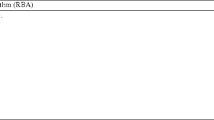Abstract
Balanced truncation is a standard and very natural approach to approximate dynamical systems. We present a version of balanced truncation for model order reduction of linear time-delay systems. The procedure is based on a coordinate transformation of the position and preserves the delay structure of the system. We therefore call it (structure-preserving) position balancing. To every position, we associate quantities representing energies for the controllability and observability of the position. We show that these energies can be expressed explicitly in terms of the solutions to corresponding delay Lyapunov equations. Apart from characterizing the energies, we show that one block of the (operator) controllability and observability Gramians in the operator formulation of the time-delay system can also be characterized with the delay Lyapunov equation. The delay Lyapunov equation undergoes a contragredient transformation when we apply the position coordinate transformation and we propose to truncate it in a classical fashion, such that positions which are only weakly connected to the input and the output in the sense of the energy concepts are removed.





Similar content being viewed by others
References
Antoulas A (2005) Approximation dynamical systems. In: Society for industrial and applied mathematics (SIAM). Philadelphia, PA
Antoulas A, Sorensen D, Gugercin S (2001) A survey of model reduction methods for large-scale systems. Contemp Math 280:193–219
Bartels R, Stewart GW (1972) Solution of the matrix equation \(AX+XB=C\). Comm ACM 15(9):820–826
Beattie C, Gugercin S (2009) Interpolatory projection methods for structure-preserving model reduction. Syst Control Lett 58(3):225–232
Benner P, Mehrmann V, Sorensen D (eds) (2005) Dimension reduction of large-scale systems. Springer, Berlin
Benner P, Saak J (2011) Efficient balancing based MOR for large scale second order systems. Math Comput Model Dyn Syst 17(2):123–143
Chahlaoui Y, Lemonnier D, Vandendorpe A, Dooren PV (2006) Second-order balanced truncation. Linear Algebra Appl 415:373–384
Curtain RF, Zwart H (1995) An introduction to infinite-dimensional linear systems theory. Springer, New York
Hale J, Verduyn Lunel SM (1993) Introduction to functional differential equations. Springer, Berlin
Harkort C, Deutscher J (2011) Krylov subspace methods for linear infinite-dimensional systems. IEEE Trans Autom Control 56(2):441–447
Huesca E, Mondié S, Santos J (2009) Polynomial approximations of the Lyapunov matrix of a class of time delay systems. In: Proceedings of the 8th IFAC workshop on time-delay systems, Sinaia, Romania
Jarlebring E, Vanbiervliet J, Michiels W (2011) Characterizing and computing the \({\cal H}_{2}\) norm of time-delay systems by solving the delay Lyapunov equation. IEEE Trans Autom Control 56(4):814–825
Kharitonov V (2004) Lyapunov-Krasovskii functionals for scalar time delay equations. Syst Control Lett 51(2):133–149
Kharitonov V (2005) Lyapunov functionals and Lyapunov matrices for neutral type time delay systems: a single delay case. Int J Control 78(11):783–800
Kharitonov V (2006) Lyapunov matrices for a class of time delay systems. Syst Control Lett 55(7):610–617
Kharitonov V, Hinrichsen D (2004) Exponential estimates for time delay systems. Syst Control Lett 53(5):395–405
Kharitonov V, Plischke E (2006) Lyapunov matrices for time-delay systems. Syst Control Lett 55(9):697–706
Kharitonov V, Zhabko AP (2003) Lyapunov-Krasovskii approach to the robust stability analysis of time-delay systems. Automatica 39(1):15–20
Mäkilä P, Partington J (1999) Laguerre and Kautz shift approximations of delay systems. Int J Control 72(10):932–946
Mäkilä P, Partington J (1999) Shift operator induced approximations of delay systems. SIAM J Control Optim 37(6):1897–1912
Mastinšek M (1994) Adjoints of solution semigroups and identifiability of delay differential equations in Hilbert spaces. Acta Math Univ Comen LXIII 2:193–206
Meyer DG, Srinivasan S (1996) Balancing and model reduction for second-order form linear systems. IEEE Trans Autom Control 41(11):1632–1644
Michiels W (2002) Stability and stabilization of time-delay systems. Ph.D. thesis, Katholieke universiteit Leuven
Michiels W, Jarlebring E, Meerbergen K (2011) Krylov-based model order reduction of time-delay systems. SIAM J Matrix Anal Appl 32(4):1399–1421
Niculescu SI (2001) Delay effects on stability. A robust control approach. Springer, London
Ochoa G, Kharitonov V (2005) Lyapunov matrices for neutral type time delay systems. In: Proceedings of the 2nd International Conference on Electrical and Electronics Engineering, Mexico City, Mexico
Ochoa G, Velázquez-Velázquez J, Kharitonov V, Mondié S (2007) Lyapunov matrices for neutral type time delay systems. In: Proceedings of the 7th IFAC workshop on time delay systems, Nantes, France
Ouellette DV (1981) Schur complements and statistics. Linear Algebra Appl 36:187–295
Partington J (2004) Model reduction of delay systems. In: Blondel V, Megretski A (eds) Unsolved problems in mathematical systems and control theory. Princeton university press, Princeton, pp 29–32
Plischke E (2005) Transient effects of linear dynamical systems. Ph.D. thesis, Universität Bremen
Reis T, Stykel T (2008) Balanced truncation model reduction of second-order systems. Math Comput Model Dyn Syst 14(5):391–406
Saadvandi M, Meerbergen K, Jarlebring E (2012) On dominant poles and model reduction of second order time-delay systems. Appl Numer Math 62(1):21–34
Vanbiervliet J, Michiels W, Jarlebring E (2011) Using spectral discretisation for the optimal \({\cal H}_{2}\) design of time-delay systems. Int J Control 84(2):228–241
Velázquez-Velázquez J, Kharitonov V (2009) Lyapunov-Krasovskii functionals for scalar neutral type time delay equation. Syst Control Lett 58(1):17–25
Yan B, Tan S, McGaughy B (2008) Second-order balanced truncation for passive order reduction of RLCK circuits. IEEE Trans Circuits Syst II Analog Digit Signal Process 55:942–946
Zigic D, Watson L, Beattie C (1993) Contragredient transformations applied to optimal projection equations. Linear Algebra Appl 188–189:665–676
Acknowledgments
This work has been supported by the Programme of Interuniversity Attraction Poles of the Belgian Federal Science Policy Office (IAP P6-DYSCO), by OPTEC, the Optimization in Engineering Center of the K.U. Leuven, and by the project STRT1-09/33 of the K.U. Leuven Research Council. The first author is supported by the Dahlquist research fellowship.
Author information
Authors and Affiliations
Corresponding author
Rights and permissions
About this article
Cite this article
Jarlebring, E., Damm, T. & Michiels, W. Model reduction of time-delay systems using position balancing and delay Lyapunov equations. Math. Control Signals Syst. 25, 147–166 (2013). https://doi.org/10.1007/s00498-012-0096-9
Received:
Accepted:
Published:
Issue Date:
DOI: https://doi.org/10.1007/s00498-012-0096-9




